Please Note: Firefox and some other search engines are not suitable
– Use “Internet Explorer” for this page to load perfectly!
Click the logo above to
reach the ssMaritime FrontPage for News Updates & “Ship of the Month”
With Reuben
Goossens
Maritime Historian, Cruise‘n’Ship
Reviewer, Author & Maritime Lecturer
Please Note: All ssMaritime and other related
maritime/cruise sites are 100% non-commercial and privately owned. Be assured
that I am NOT associated with any shipping or cruise companies or any
travel/cruise agencies or any other organisations! Although the author has been
in the passenger shipping industry since 1960, although is now retired but
having completed around 680 Classic Liners and
Cargo-Passengers Ships features I trust these will continue to provide classic
ship enthusiasts the information the are seeking, but above all a great deal of
pleasure!
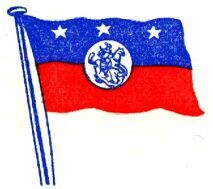
Cogedar Lines
MS Flaminia
Page Four
The Ingolf Schreiber Story

All photographs and images on this page are by or
provided by Mr. Ingolf Schreiber
Nineteen year old Ingolf decided to go to
Like young men do, he made many shipboard friends and from all accounts, as we will read from his own story, he had a wonderful and an eventful voyage.
Ingolf Schreiber
reminisces on his 1960 Flaminia Voyage
Introduction
I had already decided whilst I was an apprentice
to emigrate to
My other reason for wanting to go was the desire for adventure and to see other countries. After I had completed my apprenticeship, I sent an application to the Australian immigration office in Cologne, then on February 9, 1960 I received a letter from that Office of the Australian Embassy telling me to report to Uberseeheim Haus Number 100 in Bremen-Lesum at 8.30 on March 15 for a medical examination and an examination of my application by an officer from the Australian authorities. Needless to say, I was very excited and happy to comply, and went there by train.
All was well with the medical, the interview
and my documents, so then I had to wait for their decision. Fortunately, it
didn't take long, and on April 8, I was informed by the Inter-governmental Committee for European Emigration Liaison Office of
the West German Government in
Bad Godesberg that my application had been
approved and the instructions I received were as follows: Date of departure: April 23, 1960 from Bremerhaven aboard the MS (Motor ship) "Flaminia."
Obviously I had to immediately confirm my wish to go. In order to complete the
necessary embarkation formalities, they said please be ready to depart by 1400
(2pm) on April 22, 1960 in the Overseas
Terminal in
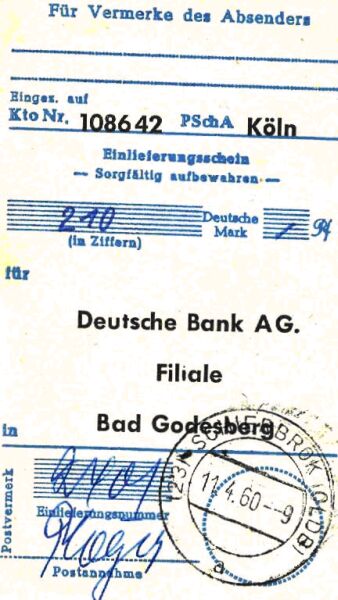
Receipt for Ingolf’s
210 DM’s
I received written confirmation of my booking on the 14th. There were now only eight days before departure, which wasn't long to get everything ready, including giving notice at work. I still had a couple of days' holiday so I was able to return to Langeoog to say goodbye to my family, so that was an emotional time.
On the 23rd I returned to Bremen-Lesum, and was assigned a bed in Room 1, Haus Number 99. I had to share the room with a couple of other people. In Lesum I also got my passenger number, which was 948.
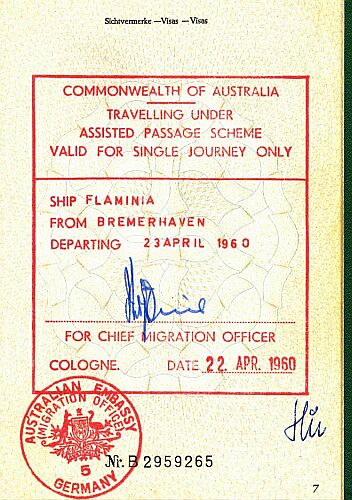
Ingolf’s
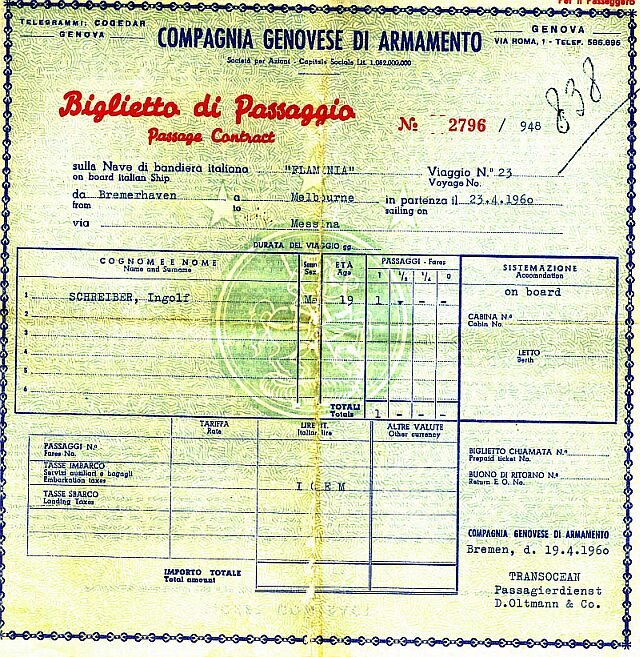
MS Flaminia’s
passage ticket
In the evening we celebrated in the
"Golden Anchor", then the next morning we
went by train to the Columbus Quay in
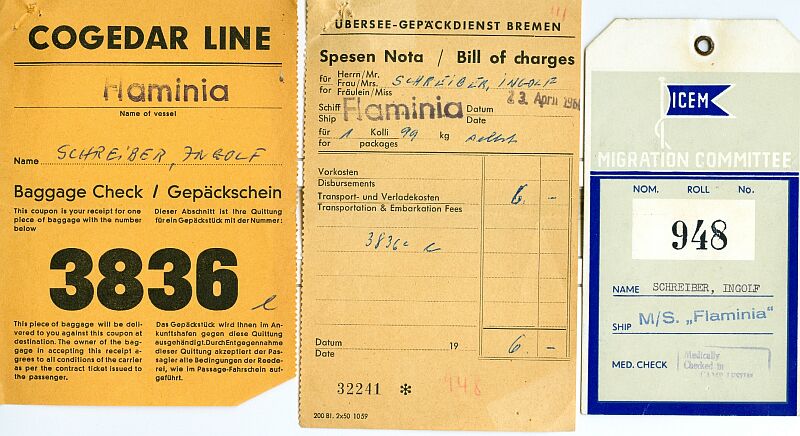
1. Baggage check – 2. Luggage charges –
3. Passenger number 948
When we'd cleared
customs, we went on board the "Flaminia", an Italian
emigration/passenger ship run by the Cogedar Line Compagnia
Genovese di Armamento. It was built in the
Two former colleagues, who had visitors' cards and were able to come onboard for a while, came to say goodbye. At first everything was at sixes and sevens while everyone was looking for their cabin. The crew was kept busy trying to create order! I eventually found my allocated 8-berth cabin, where I had a lower bunk.
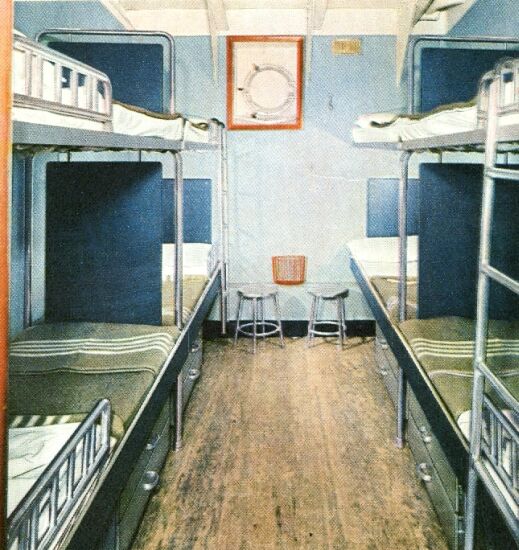
Ingolf’s 8 berth cabin was
identical to this
Bathroom facilities, consisting of share
toilets, showers and hand basins, were just a few metres from our cabin. There were
two stools to sit on in our cabin, and under our bunks were drawers for our
luggage. There was only one porthole, which was about 1.5 metres above the
waterline. We could open it in calm weather, but in stormy weather it had to be
closed and bolted down. We cast off from the Columbus Quay towards evening on
April 23 to the sound of the popular German song "Muss I Denn" and headed towards
The trip would take five weeks, and the ports
of call were as follows: From Bremerhaven we sailed to the North Sea, the
English Channel, Bay of Biscay, Strait of Gibraltar, Mediterranean Sea to
Messina in Sicily, then to Port Said in Egypt, Suez Canal, Red Sea to Aden in
Yemen, Indian Ocean to Fremantle in Western Australia, then on to our final
destination, Melbourne. From there I had to take the ferry from
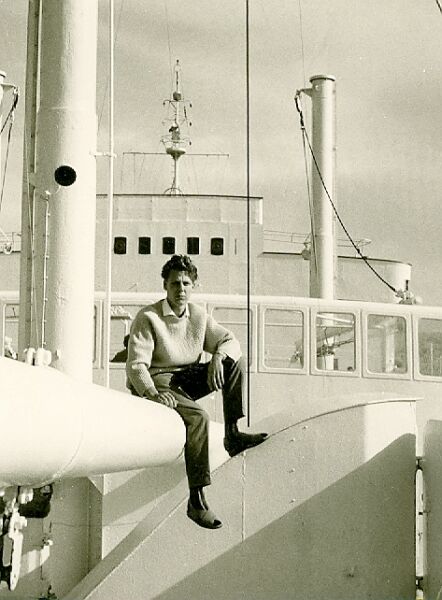
Here we meet the 19 year old
Ingolf for the first time on the foredeck of the MS
Flaminia
The Voyage
So, how was it to travel by ship in
1960?
The eight of us who shared the cabin soon got
to know one another. We were of similar age and got along well right from the
start. We struck our first storm in the
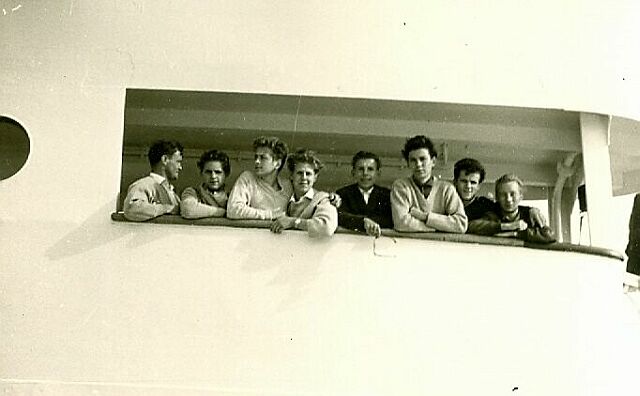
The eight cabin mates – Ingolf
is 4thffrom the left
After breakfast the next day we went exploring. There were several bars, sporting facilities and a small pool available. And every now and then, when the weather was fine, a film would be screened on deck in the evening.
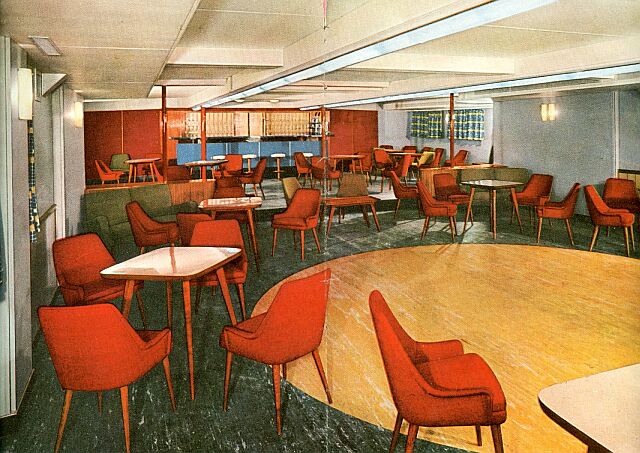
One of the comfortable Lounges and Bars onboard
Lunch was served in two sittings. When it was rough, we could eat the food which those who were seasick were unable to manage, which was something we always looked forward to. I found the food, which was mainly Italian, quite good, but I wasn't particularly fussy!
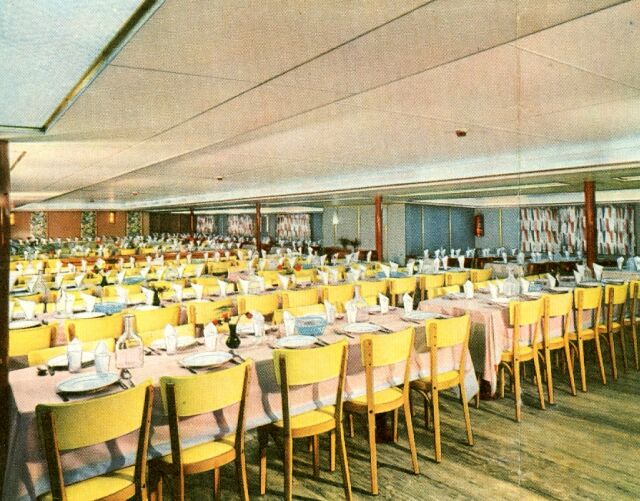
The Dining Room with its long tables
It was calmer when we got to the Channel, and
also when we went through the
We passed the time on deck, gazed into the waves, sat together in the bars, played table tennis and took advantage of the many other activities on offer, we were certainly never bored on the Flaminia.
There was a light swell when we arrived at
After much haggling through our porthole I
purchased a horse-whip with a stiletto. I reached out
and grabbed it with one hand, while holding my money firmly in the other, the
Egyptian doing the same, then we each let go at the same time. I soon
discovered that the blade was made of cheap iron. Other passengers bought a fez
which they later wore all over the ship.
Due to lack of time we were unable to leave
the ship here. We departed in the evening and headed for the
The city was surrounded by a mountain range,
and there was very little vegetation. In those days
Also while we were on the
Then one day this man drank too much in a bar
and, when he was unable to pay, had to give his name and cabin number. He
wanted to go and get his money so he could pay later, but when he hadn't paid by the next day, they went to look for him in
his cabin and discovered that he'd given the name and number of another
passenger. He was only found a few days later in a shower where he'd slept. He'd locked the door
from the inside, but the crew had a master key, so they opened the door and
arrested him. Then, when we were sailing, he had to work, and when we were in
ports he was locked up. But I have no idea what became of him after that.
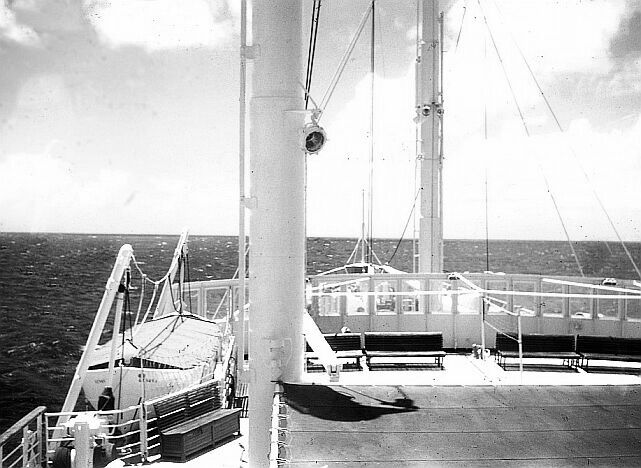
The forward sports deck looking out to sea
It took us two weeks to cross the Indian Ocean
from
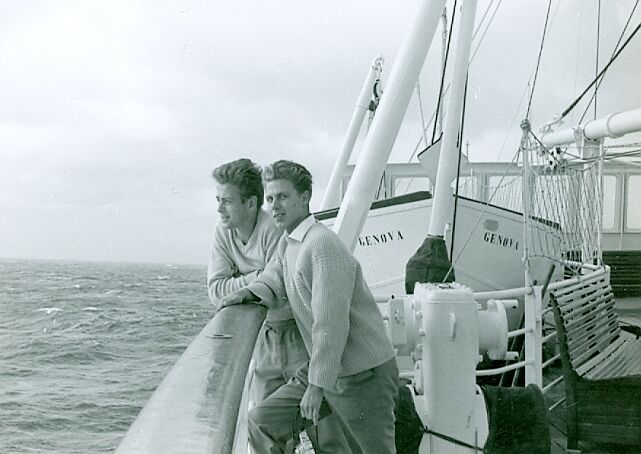
Ingolf and a friend looking out for some flying fish
– port side on the forward sports deck
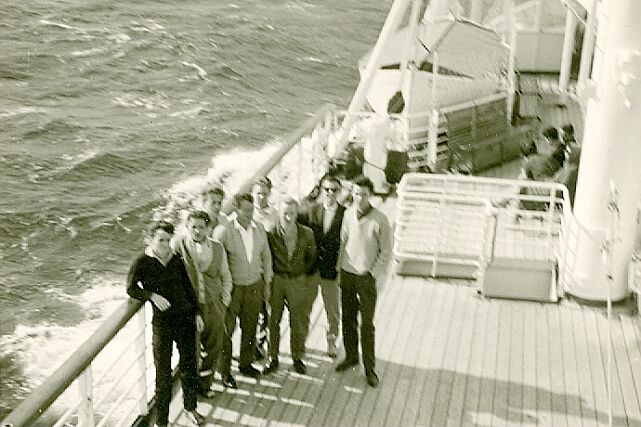
With a group of friends – starboard on the aft
deck
We had a
lot of fun during those two weeks. We crossed the equator on May 17, 1960 and
were baptized in style. "Neptune" and his assistants came up with an
idea for the baptism: first of all, you had to kneel down before
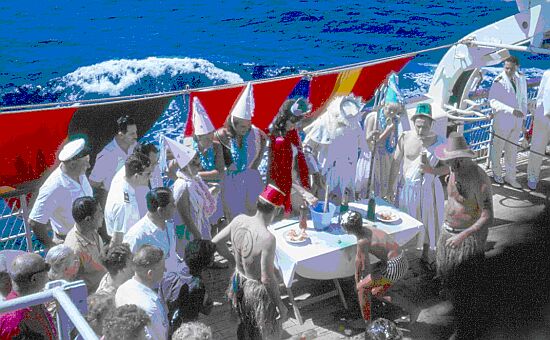
Ingolf receiving his baptism from King Neptune’s
servants’
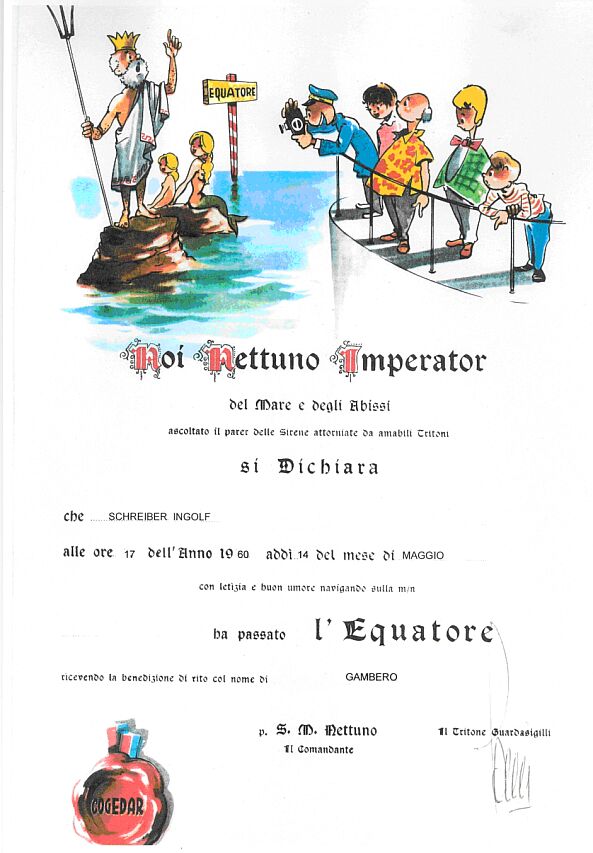
Ingolf’s crossing the Equator Certificate
A few days before we reached
When we reached Fremantle, the first emigrants left the ship. The rest of us were also allowed off for a few hours (not long enough to see much) and we found that we couldn't walk properly because it felt as though the ground beneath our feet was moving.
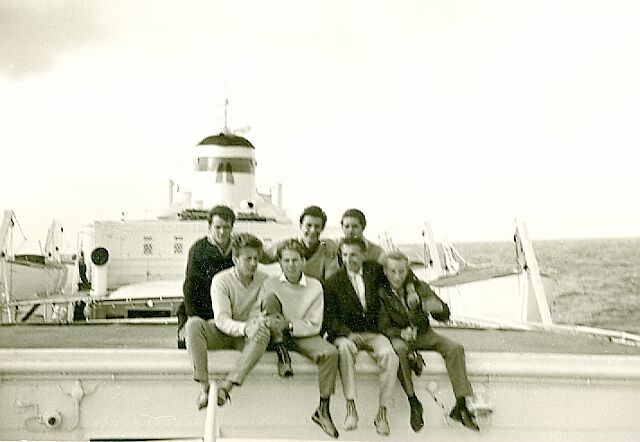
The cruise is coming to an end and friends have
stuck together, but soon they have to say goodbye!
Then it was on to
Those of us who did have somewhere to go went on to catch their trains or those of us who did have somewhere to go went on to catch their trains or buses. Of the eight in my cabin, three of us (including me) had a job lined up, and the rest went to Bonegilla. I have never had any contact with any of them since, so I have no idea what became of them.
The Ferry to Tasmania
After I had passed through customs and
immigration and all my papers were found to be in order, I was taken, along
with other people I didn't know, by bus to the port in
plenty of facilities.
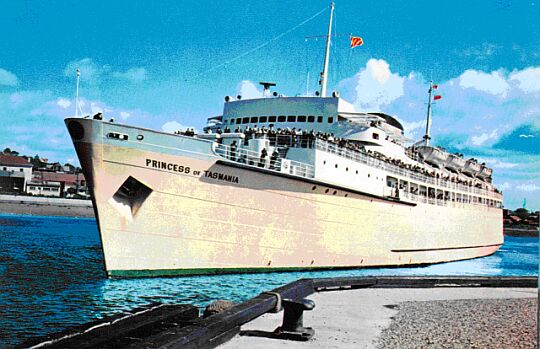
Princess of
My next destination was Tarraleah, where my brother an I
both worked for the then Hydro Electric
Commission (
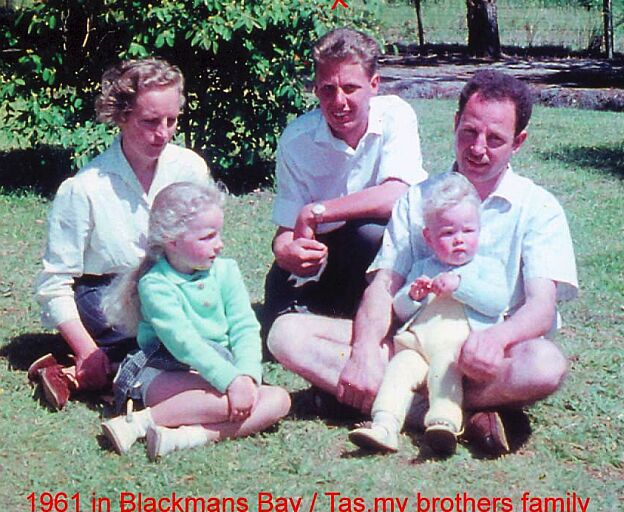
My brother and family were ready and waiting for me
in
Later I lived and worked in two other Hydro villages, Wayatinah and Poatina (the names are Aboriginal). Then I went back to the mainland to travel up the east coast as far as to Cooktown and into the red outback, because I was really interested in seeing this vast country.
In March 1962, I decided to return to
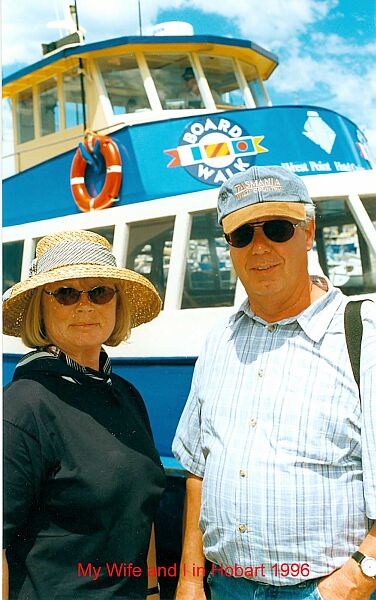
My wife and myself during a visit to
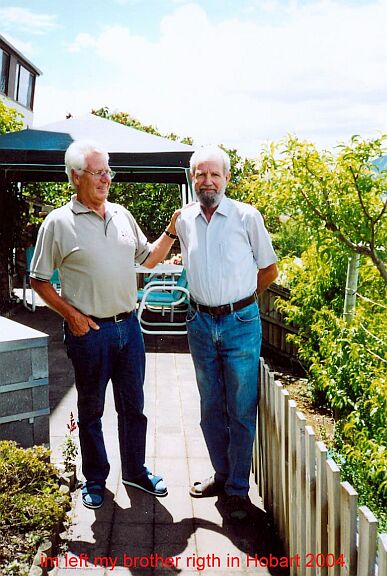
Another visit in 2004, seen with my brother in Tassie on the right
I might be living in
Ingolf Schreiber
PS: If
anyone reading this was also on the MS Flaminia from
Page One: MS Flaminia History Page
Page Two: A
Holocaust Survivor sails to Australia
Page Three: Lifelong
friends sail to Australia in 1958
Page Four: Ingolf Schreiber’s Voyage in 1960
Also visit:
“Blue
Water Liners sailing to the distant shores.
I watched them come, I watched them go and I watched them die.”
****************************
Visit our ssMaritime
Main INDEX
Where you will discover around 680 Classic
Passenger & Passenger-Cargo Liners!
ssMaritime.com &
ssMaritime.net
Where the ships of the past make history & the 1914 built MV Doulos Story
Please Note: ssmaritime and associated sites are 100% non-commercial
and the author does not seek funding or favours and never have and never will.
Photographs on ssmaritime and associate pages are
either by the author or from the author’s private collection. In addition
there are some images and photographs that have been provided by Shipping
Companies or private photographers or collectors. Credit is given to all
contributors, however, there are some photographs provided to me without
details regarding the photographer or owner concerned. Therefore, I hereby
invite if owners of these images would be so kind to make them-selves known to
me (my email address can be found at the bottom of the page on www.ssmaritime.com),
in order that due credit may be given.
ssMaritime is owned & © Copyright by Reuben
Goossens - All Rights Reserved
